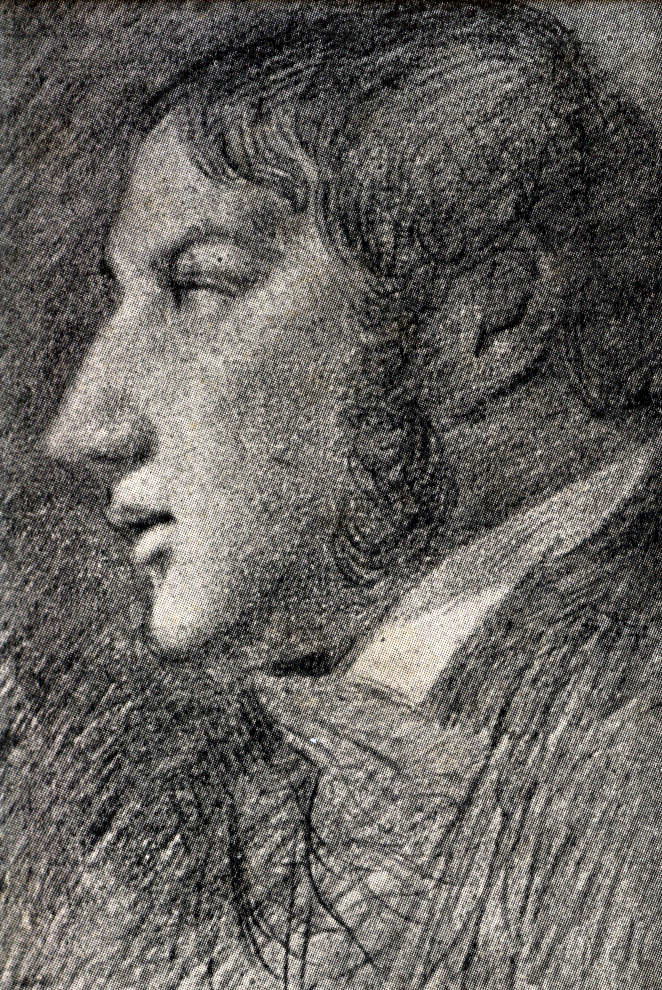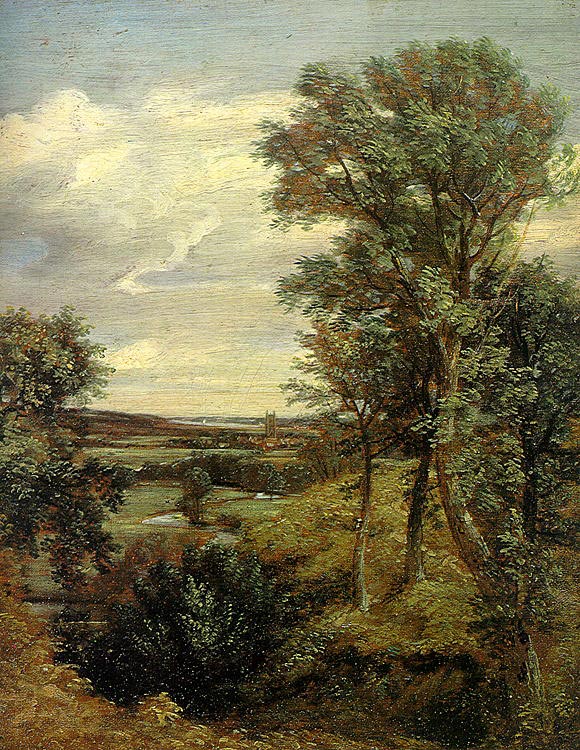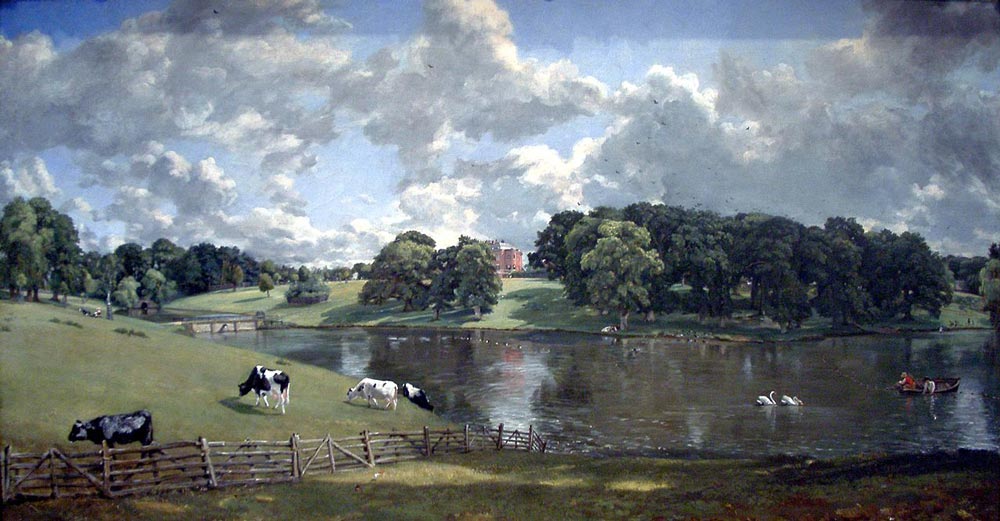| John Constable | |
|---|---|
 |
|
| Born | June 11, 1776 East Bergholt, Suffolk, East Anglia, England |
| Died | March 31, 1837 (at age 60) Hampstead, London, England |
| Nationality | English |
| Movement | Romanticism |
| Field | Painting |
| Works | View Complete Works |
John Constable (1776-1837) was the second child of his parents. John’s father, a wealthy corn mill merchant, owned and operated two corn mills. Although it was customary for the eldest son to take over the family business, because John’s elder brother was born mentally-disabled, John himself would be expected to assume the responsibility.
As a young man, John attended a Levanham boarding school. He later attended a public school in their hometown of Dedham. When John left school he began work in the corn mill until his eldest brother began to run the business after all. John, now free to pursue his own dreams and interests began sketching landscapes. This was the beginning of his early career as an artist.
Early Travels
John set out on various amateur sketching trips around the countryside of Suffolk. Scenes such as the views of his homeland’s countryside were to be the subject of the majority of his art pieces. John stated at one time that the beloved scenes of his own homeland made him the painter he was. John received his inspiration to paint professionally while viewing a beautiful specimen of art owned by an acquaintance and collector, George Beaumont. Sometime later while in Middlesex visiting family, he had the opportunity to meet a professional in the field of art. John T. Smith advised John Constable on painting but strongly urged him to not endeavor to take up painting professionally, but rather to stay working in his father’s business. This advice, though well-meant, went against John’s dreams and desires.
Aspirations Fulfilled
 In 1799, when he was twenty-three, John was able to convince his father to grant him permission to study art and with a small allowance and his father’s blessings. He set off to school. Elated over his father’s approval, John enrolled at the RA. For the next few years John would study life classes, analysis of the body as art, and also attempt to recreate the art works and styles of the old masters of the field. During his studies John was especially inspired by the works of several artists, namely T. Gainsborough, C. Lorrain, Peter P. Rubens and others. Additionally he enjoyed reading poetry as well as sermons. In years to come he proved to be an exceptionally eloquent artist. In 1803, he showed his works at the same art School where he studied.
In 1799, when he was twenty-three, John was able to convince his father to grant him permission to study art and with a small allowance and his father’s blessings. He set off to school. Elated over his father’s approval, John enrolled at the RA. For the next few years John would study life classes, analysis of the body as art, and also attempt to recreate the art works and styles of the old masters of the field. During his studies John was especially inspired by the works of several artists, namely T. Gainsborough, C. Lorrain, Peter P. Rubens and others. Additionally he enjoyed reading poetry as well as sermons. In years to come he proved to be an exceptionally eloquent artist. In 1803, he showed his works at the same art School where he studied.
Just three years later, he was offered a position as drawing master of the Great Marlow Military Academy. The royal Academy drawing master had advised John that should he accept the offered position, it would surely mean the demise of the budding young artist’s career. Also during this same year John Constable drafted a letter to letter to Mr. J. Dunthorne. In the letter he explained his goal to become a landscape artist. He painstakingly explained that for the previous few years he had been chasing various pictures, searching the truth and receiving second hand knowledge. He stated that he had not enjoyed representing nature as he had always desired but rather endeavored to attempt to make my drawings look like the drawings of other artists before him.
A Style of His Own
 John Constable (1776-1837) held to his desires to paint scenes of typical daily life for most of his adult life. In fact his early style of art shares qualities of his later pieces such as freshness of light, touch, and color, and portrays the inspirations of the masters he once studied, specifically that of Claude Lorrain. In an era when more romantic views of wild untamed landscapes and ruins John Constable’s usual paintings of everyday life were out of style.
John Constable (1776-1837) held to his desires to paint scenes of typical daily life for most of his adult life. In fact his early style of art shares qualities of his later pieces such as freshness of light, touch, and color, and portrays the inspirations of the masters he once studied, specifically that of Claude Lorrain. In an era when more romantic views of wild untamed landscapes and ruins John Constable’s usual paintings of everyday life were out of style.
No Place Like Home
Although John Constable declined the offered position from the Great Marlow Military Academy he did make intermittent trips further inland. For instance, in 1803 he spent about a month on board the vessel East Indiaman as she visited several ports. Three years later he took a two-month visit touring the Lake District. Afterwards he found the peace and serenity of mountain views relaxing and enjoyable to others, but were to him depressing. Having always been a social creature. He needed the socialization of villages, houses of worship, farms and cottages.
In need of capital to fund his art travels and supplies John began painting portraits. This was a drudging employment that he loathed doing but he created many beautiful portraits and for the time being it would pay for his needs. At this time John Constable also painted several religious portraits however, as was noted by John Walker these religious portraits easily portrayed Constable’s inadequacies as an artist of religious figures. Constable was however lured by the beauty of a cathedral and the breathtaking landscape of Salisbury, a city he had toured when visiting the Fisher family in 1811.
Troubled Waters
 In 1816 John became engaged to his childhood friend; Maria Bicknell however their engagement met with great resistance from Maria’s grandfather who felt the Constable’s were beneath his family’s social stature. Maria was told that if she dared to marry Constable she would immediately be disinherited by her grandfather. Maria’s father not wanting his daughter to experience the consequences of her actions strongly advised against the union. Constable’s own parents although approving of the union held out no expectations, encouraging the marriage until such time that John himself gained financial security but they passed away rather quickly each following the other and John inherited a fifth of the family business. In October 1816 John and Maria were married. It was not long before John Constable’s paintings began to take on new life, the colors were brighter, livelier, and crispier.
In 1816 John became engaged to his childhood friend; Maria Bicknell however their engagement met with great resistance from Maria’s grandfather who felt the Constable’s were beneath his family’s social stature. Maria was told that if she dared to marry Constable she would immediately be disinherited by her grandfather. Maria’s father not wanting his daughter to experience the consequences of her actions strongly advised against the union. Constable’s own parents although approving of the union held out no expectations, encouraging the marriage until such time that John himself gained financial security but they passed away rather quickly each following the other and John inherited a fifth of the family business. In October 1816 John and Maria were married. It was not long before John Constable’s paintings began to take on new life, the colors were brighter, livelier, and crispier.
The First Sale
The White Horse was Constable’s first painting to sell in 1819 and led to the making of several large scale canvases that were six feet tall. Besides his first sale he was also elected as the associate of RA. He won his first Gold Medal in 1824 for the painting of Hay Wain, which had been purchased and was being shown in Paris at a salon.
Throughout his life Constable would only sell a small number of paintings in his home country whereas in Paris he sold greater than twenty in a matter of a few years. Constable declined invitations to visit other areas abroad and show his paintings. Perhaps if he had agreed his profits would have earned him the income his talents deserved.
Loss of the Nightingale
Following the delivery of her last child, Maria passed away after succumbing to tuberculosis that November. Maria was forty-one at her death. Riddled with deep sorrow and depression at his beloved wife’s passing Constable raised children alone and never wore anything but black clothing for the remainder of his life.